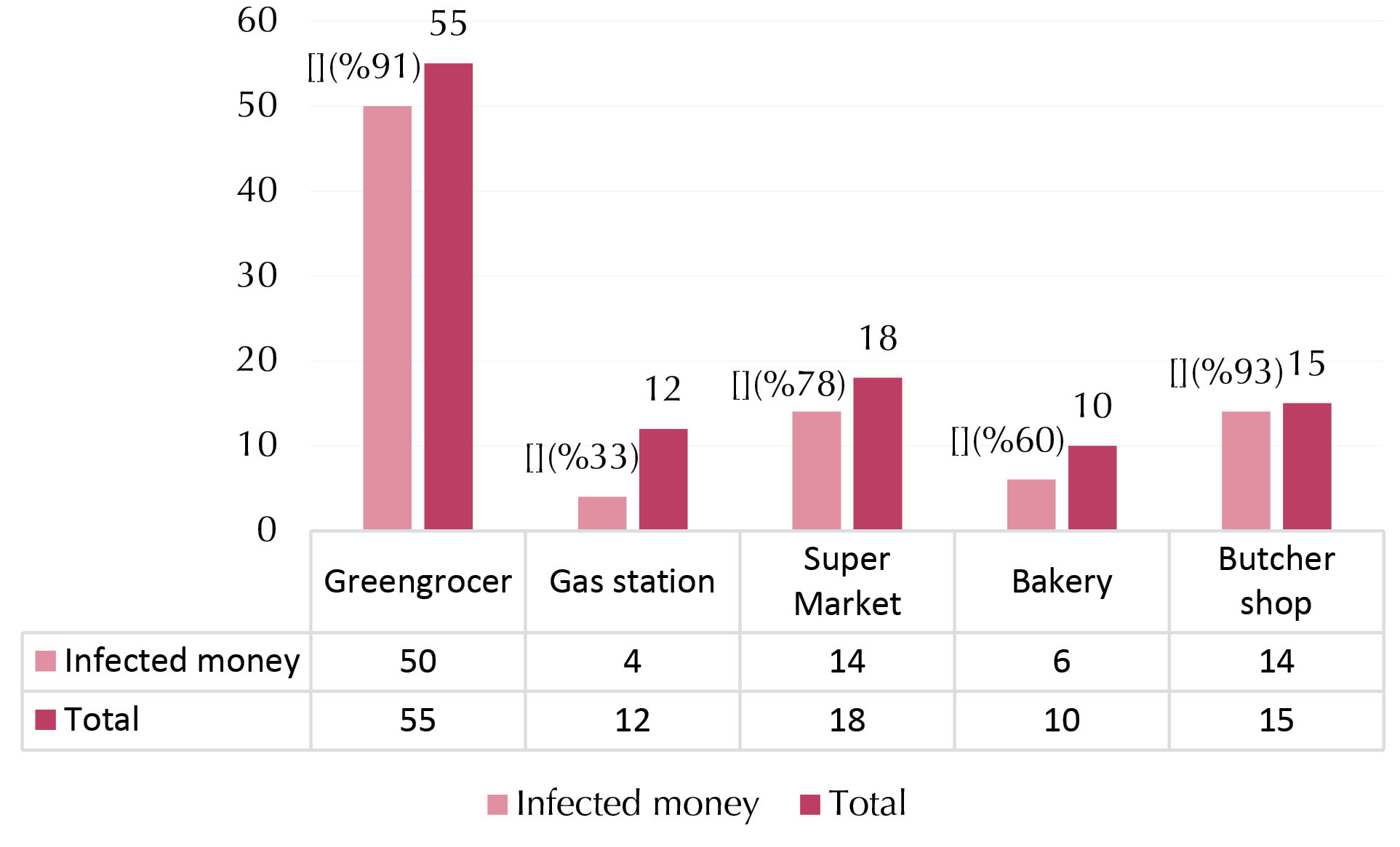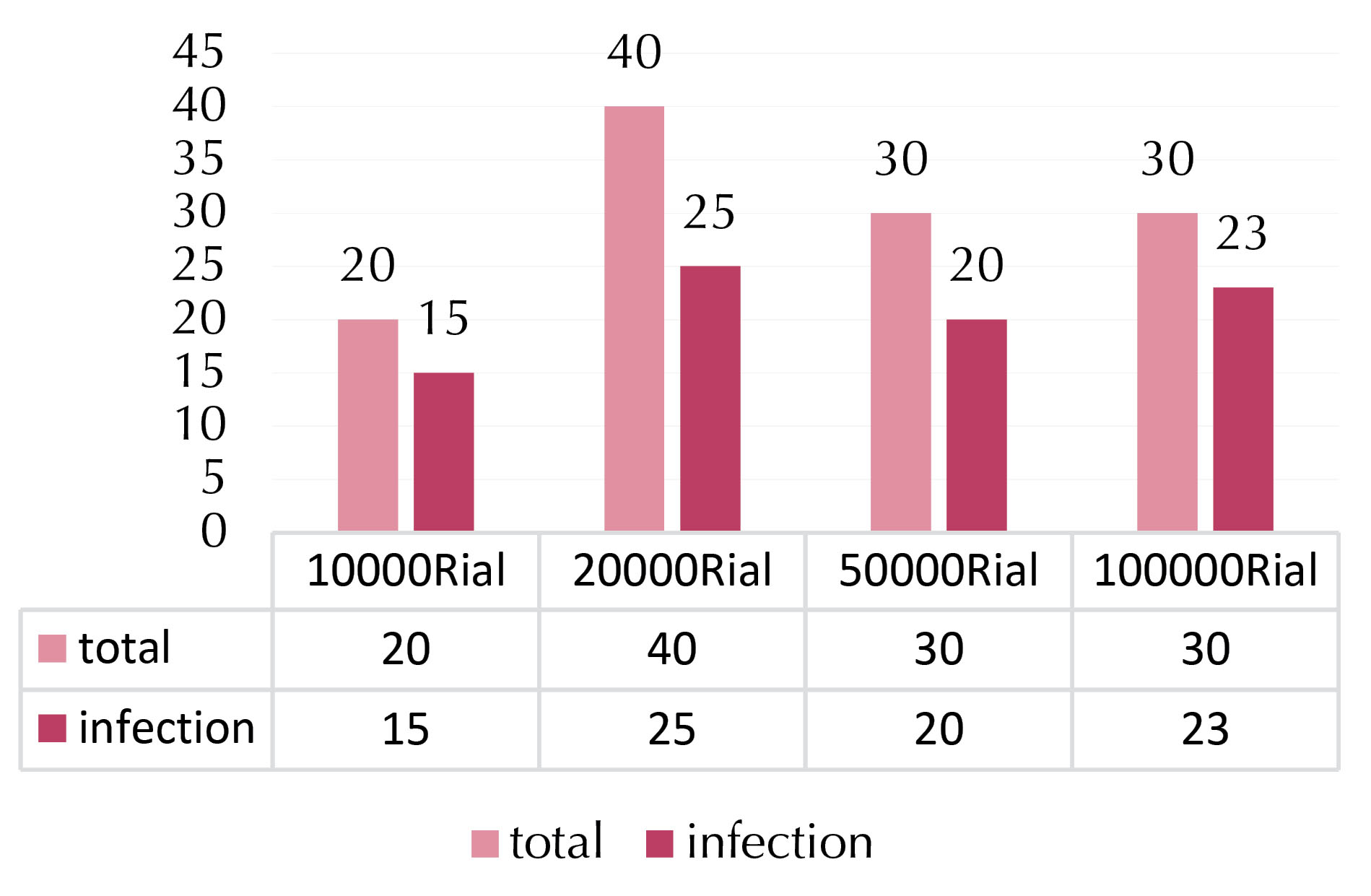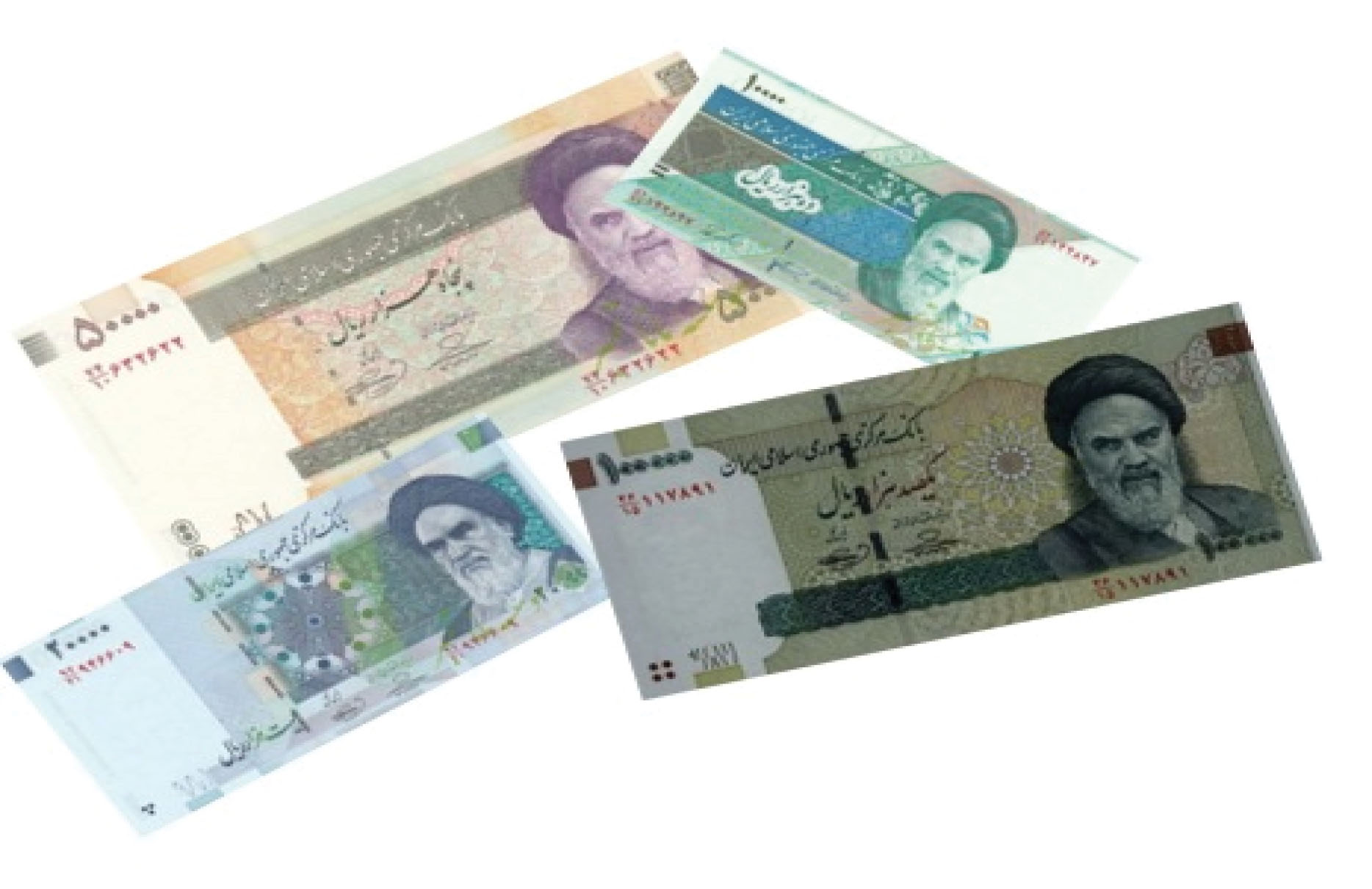Avicenna Journal of Clinical Microbiology and Infection. 7(1):27-30.
doi: 10.34172/ajcmi.2020.05
Original Article
Prevalence of Parasitic Contamination of Paper Money in Fars Province of Iran
Arash Hasannezhad 1  , Zahra Rezaie 1, Zeinab Kiani 1, Ahmad Abolghazi 1, 2, *
, Zahra Rezaie 1, Zeinab Kiani 1, Ahmad Abolghazi 1, 2, * 
Author information:
1Department of Medical Parasitology, Jahrom University of Medical Sciences, Jahrom, Iran.
2Zoonoses Research center, Jahrom University of Medical Sciences, Jahrom, Iran.
*
Corresponding author: Ahmad Abolghazi,Department of Medical Parasitology, Jahrom University of Medical Sciences, Jahrom, Iran. Email:
ahmadabolghazi@gmail.com
Abstract
Background: Money is one of the most commonly used microbial carriers. Parasites are no exception to this rule. Thus, this study aimed at investigating the presence of parasitic species in paper money collected from various sources in Fars Province and suggesting ways to improve community health.
Methods: In this study, banknotes were randomly collected from people from different rural and urban areas of Fars province between March 2018 and November 2019. In addition, these banknotes were gathered from various sources including butchers, bakers, supermarkets, gas stations, and vegetable shops and stored at Diluted Water (DW). Then, they were extracted from the water and the solution was centrifuged at 3000 rpm. The surface water was drained and expanded from the remaining materials, stained with Giemsa color, and finally, observed under a microscope.
Results: In the urban areas, 2 (3.7%), 22 (40.7%), 8 (14.8%), 4 (7.4%), 4 (7.4%), 12 (22.3%), and 2 (3.7%) contaminations were related to Giardia lamblia, Entamoeba coli, Endolimax nana, Ascaris lumbricoides, Hookworm, unknown larvae, and Hymenolepis nana, respectively. In the rural areas, 4 (11.7%), 8 (23.5%), 6 (17.6%), 2 (5.8%), 4 (11.7%), and 10 (29.4%) infections were related to Giardia lamblia, Entamoeba coli, Endolimax nana, Ascaris lumbricoides, Hookworm, and to unknown larvae, respectively.
Conclusions: According to the results, hand hygiene is important for promoting community health since hands are largely in contact with money.
Keywords: Parasitic contamination, Paper money, Fars
Copyright and License Information
© 2020 The Author(s); Published by Hamadan University of Medical Sciences.
This is an open-access article distributed under the terms of the Creative Commons Attribution License (
http://creativecommons.org/licenses/by/4.0), which permits unrestricted use, distribution, and reproduction in any medium provided the original work is properly cited.
Background
Most of the things we use in daily life can be a potential carrier of pathogenic microorganisms. In addition, the contamination of various objects by potentially pathogenic microorganisms has been causing serious public health concerns (1,2) because the items passing from one side to another create the possibility of contamination with a wide range of pathogenic microorganisms. Although people ignore pathogenic microorganisms, they are unconsciously in contact with many of these microorganisms through some of the media they use, including the money from all categories (3-5). In terms of health and hygienic standards, money is used by different people and is stored under various environmental and personal health conditions. Further, paper money is widely traded for goods and services. Some gram-negative bacteria can remain on the coin for up to 11 days although many coins contain copper that can inhibit the growth of microbes. The paper money provides a larger surface for the growth of pathogens thus microbes may live longer on this type of money. More germs can accumulate on older money while less-touched and less-traded money has fewer microbes (6-8). Furthermore, money can often be used as an unknown source of pathogenic and non-pathogenic bacteria. Data collected over the last 2 decades indicates that the simultaneous handling of paper money and food is associated with food-borne disease cases.Ogo et al reported that the source of contamination could be a consequence of poor money management techniques such as throwing paper money over people in ceremonies. The money falls on the ground and people who have this money in their hands pour some of their flora into the money, which leads to the spread of microorganisms among other people (9). In addition, money can be contaminated by dust, soil, and water, as well as the microflora of the body (hands, skin, and the like) and saliva (10). Most people do not carry money in wallets, especially in the women’s market, motorcycles, bus drivers and their occupants, butchers and meat sellers, restaurant operators, and the like. For example, women often keep money under their brassieres and the carpet and men keep it in their socks. Men and women in the market cover paper money and put them in their dirty pockets (11). These money management habits can transfer germs to money. Similarly, the storage of paper money in polyethylene, cotton, and leather bags in wet and dark conditions results in the growth of microorganisms as well (12). Unfortunately, there are few studies on the contamination of money with microbial agents in most developing countries. The lack of information may result in the lack of public health politics regarding the use, handling, and circulation of paper money. This is due to the inability of some governments to eradicate old, worn out, and incompatible paper currencies of circulation. This situation can play a significant role in the transmission of some pathogens and decrease the level of health.
To sum up, people who live in unhealthy conditions use money with microorganisms in the infected hands after using the toilet, count paper money using saliva, cough and sneeze, and finally, place or store paper currencies, which are polluted by dirty surfaces. These currencies act as the means of infection to the next user’s hand. As a result, paper currencies play an important role in the transmission of pathogenic microorganisms and cause a significant risk to public health (13,14). Therefore, this study aimed to evaluate the prevalence of the parasitic contamination of paper money in Fars Province, Iran.
Materials and Methods
In this study, a total number of 110 banknotes were randomly collected from people in different rural (40 samples) and urban (70 samples) areas of Fars province between March 2018 and November 2018. Such banknotes were gathered from various sources including butchers, bakers, supermarkets, gas stations, and farmers’ markets. The paper money was collected with sterile gloves and placed in sterile containers. The samples were then transferred to the laboratory and were immediately deposited in DW (15). After separating the money from the waters, the solution was centrifuged at 3000 rpm. Then, the surface water was drained and expanded from the remaining materials and stained based on the Giemsa staining protocol and ultimately observed under the microscope (16).
Results
In general, 110 samples were collected out of which, 88 cases were infected with the parasites, including 54 and 34 samples which were collected from urban and rural areas, respectively (Figure 1).

Figure 1.
Prevalence of Contamination in Urban and Rural Areas in Parasitic Contamination of Paper Money in Fars Province of Iran.
.
Prevalence of Contamination in Urban and Rural Areas in Parasitic Contamination of Paper Money in Fars Province of Iran.
The level of contamination from urban and rural areas was identified as follows. The highest level of contamination in both urban and rural areas was related to the money collected from the greengrocer (Figure 2).

Figure 2.
The Prevalence of Parasitic Contamination in the Paper Money From Various Jobs in the Fars Province of Iran.
.
The Prevalence of Parasitic Contamination in the Paper Money From Various Jobs in the Fars Province of Iran.
In the urban areas, of 54 contaminations, 2 (3.7%), 22 (40.7%), 8 (14.8%), 4 (7.4%), 4 (7.4%), 12 (22.3%), and 2 (3.7%) samples were related to Giardia lamblia (cyst), Entamoeba coli (cyst), Endolimax nana (cyst), Ascaris lumbricoides (egg), hookworm (egg), unknown larvae, and Hymenolepis nana (egg), respectively (Table 1).
Table 1.
The Prevalence of Parasitic Contamination in the Paper Money From Urban Areas in Fars Province of Iran
|
|
Greengrocer
|
Gas Station
|
Supermarket
|
Bakery
|
Butchers Shop
|
|
Giardia lamblia (cyst) |
2 (3.7%) |
0 |
0 |
0 |
0 |
|
Entamoeba coli (cyst) |
6 (11.1%) |
4 (7.4%) |
6 (11.1%) |
2 (3.7) |
4 (7.4%) |
|
Endolimax nana (cyst) |
4 (7.4%) |
0 |
2 (3.7%) |
0 |
2 (3.7%) |
|
Ascaris lumbricoides (egg) |
2 (3.7%) |
0 |
0 |
0 |
2 (3.7%) |
|
Hookworm (egg) |
2 (3.7%) |
0 |
0 |
0 |
2 (3.7%) |
|
Unknown larvae
|
6 (11.1%) |
0 |
4 (7.4%) |
2 (3.7%) |
0 |
|
Hymenolepis nana (egg) |
2 (3.7%) |
0 |
0 |
0 |
0 |
In the rural areas, 4 (11.7%), 8 (23.5%), 6 (17.6%), 2 (5.8%), 4 (11.7%), and 10 (29.4%) of the infections were related to Giardia lamblia (cyst), Entamoeba coli (cyst), Endolimax nana (cyst), Ascaris lumbricoides (egg), hookworm (egg), and unknown larvae, respectively (Table 2).
Table 2.
The Prevalence of Parasitic Contamination in the Paper Money From Rural Areas in Fars Province of Iran
|
|
Greengrocer
|
Super Market
|
Bakery
|
Butchers Shop
|
|
Giardia lamblia (cyst) |
4 (11.7%) |
0 |
0 |
0 |
|
Entamoeba coli (cyst) |
4 (11.7%) |
2 (5.8%) |
0 |
2 (5.8%) |
|
Endolimax nana (cyst) |
2 (5.8%) |
0 |
2 (5.8%) |
2 (5.8%) |
|
Ascaris lumbricoides (egg) |
2 (5.8%) |
0 |
0 |
0 |
|
Hookworm (egg) |
4 (11.7%) |
0 |
0 |
0 |
|
Unknown larvae
|
10 (29.4%) |
0 |
0 |
0 |
|
Hymenolepis nana (egg) |
0 |
0 |
0 |
0 |
Moreover, according to the type of collected money, the highest level of contamination was related to 100 000 rials note (Figure 3). The image of the type of the tested money is presented in Figure 4.

Figure 3.
The Prevalence of Parasitic Contamination in Different Currencies (paper money) From Fars Province of Iran.
.
The Prevalence of Parasitic Contamination in Different Currencies (paper money) From Fars Province of Iran.

Figure 4.
The Image of the Type of Money Taken From Fars Province of Iran.
.
The Image of the Type of Money Taken From Fars Province of Iran.
Discussion
Paper money is one of the most important carriers of infections in different countries (14), which can always transmit the infection from person to person. Some studies have focused on this issue (17,18). Like other studies, isolated microorganisms from paper money in Saudi Arabia showed that the contamination of paper money with infectious agents such as parasites and bacteria is a common phenomenon worldwide (11). There are several mechanisms for the transmission of these contaminants including low attention to personal hygiene after using the toilet, counting paper money using saliva, coughing and sneezing in hands and then exchanging money, and placing or storing money on dirty surfaces (11). The contact of the contaminated money with other money can lead to further transmission of contamination. Since most people are unaware that they may be infected with parasites only by touching paper money, they should wash their hands after counting and handling the money. Therefore, efforts should be made for further awareness-raising to improve how healthcare can be useful in reducing contamination when using paper money. In addition, the periodic evaluation of microbial contamination can help to reduce the transmission of these microorganisms (19).
As mentioned earlier, the findings of previous studies in other countries confirmed the significant contamination of the money by microorganisms. In this study, 80% of the tested paper money was contaminated, some of which were potentially pathogenic. In another study, Pope et al found that 94% of the US paper money was contaminated by bacteria (18). Furthermore, the contamination of 80.5% of the old Doka notes was confirmed based on the results of another study in Bangladesh (20). These statistics, similar to those reported in other countries, indicate the high likelihood of transmission of human-to-human contamination.
Hence, replacing traditional trading methods by electronic currency such as automated teller machines, encouraging the use of credit cards, washing hands continuously, especially after contacting with paper money, and increasing personal health awareness in the community can be proper solutions for this problem. If possible, the use of antimicrobial chemicals in paper and disinfectants in the banks, as well as ultraviolet light and chemicals can reduce the risk of infection transmission (19).
Conflict of Interests
The authors declare that there is no conflict of interests.
Acknowledgments
The study was financially supported by a grant from Jahrom University of Medical Sciences.
Ethical Statement
Not applicable.
Authors’ Contribution
A.H, A.A. and Z.K. designed the study. Z.R and A.A collected data. All authors discussed the results and contributed to the final manuscript.
Funding/Support
The study was supported financially by a grant from Jahrom University of Medical Sciences.
References
- Betancur CA, Estrada S, Ceballos MT, Sánchez E, Abad AM, Vanegas C. Paper currency as fomite for bacteria with human pathogenic potential. Infectio 2010; 14(2):120-6. [ Google Scholar]
- Ahmed MSU, Parveen S, Nasreen T, Feroza B. Evaluation of the microbial contamination of Bangladesh paper currency notes (Taka) in circulation. Adv Biol Res 2010; 4(5):266-71. [ Google Scholar]
- Rahman SMR, Uddin MN, Nain Z, Karim MM. Screening for microbial load and antibiotic resistance pattern in Escherichia coli isolated from paper currency circulating in Kushtia, Bangladesh. Int J Res Med Sci 2019; 7(4):1161-5. doi: 10.18203/2320-6012.ijrms20191318 [Crossref] [ Google Scholar]
- Girma G, Ketema T, Bacha K. Microbial load and safety of paper currencies from some food vendors in Jimma Town, Southwest Ethiopia. BMC Res Notes 2014; 7:843. doi: 10.1186/1756-0500-7-843 [Crossref] [ Google Scholar]
- Moses IB, Ugbo EN, Iroha IR, Ukpai EG, Odah EE, Eluu SC. Antibiogram and phenotypic characterization of E coli isolated from Nigeria’s paper currencies obtained from butchers in Ebonyi State. Arch Clin Microbiol 2018; 9(4):85. doi: 10.4172/1989-8436.100085 [Crossref] [ Google Scholar]
- Boidya J, Uddin R, Mandal SC. Microbiological analysis of Bangladeshi paper currency circulating in Dhaka city. Bioresearch Communications 2015; 1(1):53-6. [ Google Scholar]
- Sharif M, Ansari F. Evaluation of health risk from handling Pakistani currency notes and coins in Lahore. World J Pharm Res 2017; 6(6):129-59. doi: 10.20959/wjpr20176-8536 [Crossref] [ Google Scholar]
- El-Dars FM, Hassan WM. A preliminary bacterial study of Egyptian paper money. Int J Environ Health Res 2005; 15(3):235-9. doi: 10.1080/09603120500105976 [Crossref] [ Google Scholar]
- Ogo NI, Ajayi JA, Ajayi OO, Madukeke A. Eggs and cysts of parasites contaminating Nigerian currency notes. Afr J Nat Sci 2004; 7:40-42. [ Google Scholar]
- Sahab AF, Dissoki B, Sahaba S, Badie S, Hanafy O. Studies on fungal contamination of current Egyptian paper Banknotes. Int J Microbiol Res 2012; 3(1):75-81. doi: 10.5829/idosi.ijmr.2012.3.1.14412 [Crossref] [ Google Scholar]
- Girma G. Health risk associated with handling of contaminated paper currencies in circulation: a review. Am Sci Res J Eng Technol Sci 2014; 10(1):40-53. [ Google Scholar]
- Griffith CJ. Food safety in catering establishments. In: Farber JM, Todd ECD, eds. Safe Handling of Foods. New York, NY: Marcel Dekker; 2000.
- Igumbor EO, Obi CL, Bessong PO, Potgieter N, Mkasi TC. Microbiological analysis of banknotes circulating in the Venda region of Limpopo province, South Africa. S Afr J Sci 2007; 103(9-10):365-6. [ Google Scholar]
- Umeh EU, Juluku JU, Ichor T. Microbial contamination of Naira (Nigerian Currency) notes in circulation. Res J Environ Sci 2007; 1(6):336-9. [ Google Scholar]
- Diagnostic Procedures. Available from: https://www.cdc.gov/dpdx/diagnosticprocedures/index.html.
- Lowe BS, Jeffa NK, New L, Pedersen C, Engbaek K, Marsh K. Acridine orange fluorescence techniques as alternatives to traditional Giemsa staining for the diagnosis of malaria in developing countries. Trans R Soc Trop Med Hyg 1996; 90(1):34-6. doi: 10.1016/s0035-9203(96)90470-8 [Crossref] [ Google Scholar]
- Göktaş P, Oktay G. [Bacteriological examination of paper money]. Mikrobiyol Bul 1992; 26(4):344-8. [ Google Scholar]
- Pope TW, Ender PT, Woelk WK, Koroscil MA, Koroscil TM. Bacterial contamination of paper currency. South Med J 2002; 95(12):1408-10. [ Google Scholar]
- Basavarajappa KG, Rao PN, Suresh K. Study of bacterial, fungal, and parasitic contamination of currency notes in circulation. Indian J Pathol Microbiol 2005; 48(2):278-9. [ Google Scholar]
- Hosen MJ, Sarif DI, Rahman MM, Azad MA. Contamination of coliforms in different paper currency notes of Bangladesh. Pak J Biol Sci 2006; 9:868-70. doi: 10.3923/pjbs.2006.868.870 [Crossref] [ Google Scholar]